To build a zero-waste soap making system, you'll need essential tools like a sturdy cutting board, sharp soap cutter, digital scale, and airtight storage containers. Start by organizing your workspace with clearly labeled containers to sort trimmings by category. You can repurpose scraps through melting, reforming into new bars, or creating innovative products like natural detergents and bath items. This sustainable approach can reduce material costs by 30% while attracting eco-conscious customers. Discover how these practical solutions can transform your artisan practice.
Essential Tools for Collecting Soap Trimmings
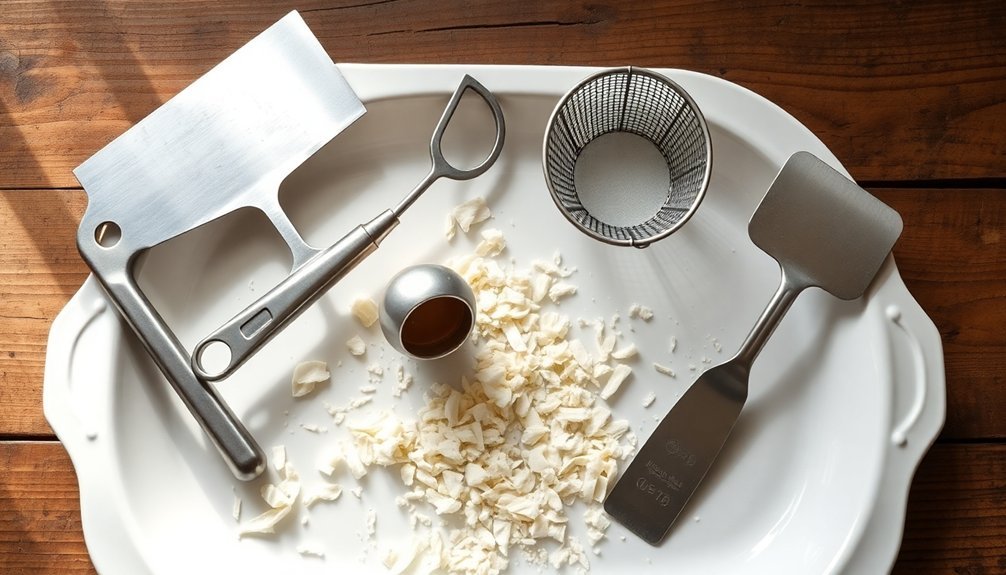
When setting up your zero-waste soap-making workspace, you'll need specific tools to efficiently collect and manage soap trimmings. Start with a sturdy cutting board and sharp knife or soap cutter to safely slice leftover pieces into uniform sizes.
You'll also want a digital scale to measure trimmings accurately, helping you track available material for future projects.
Store your collected soap trimmings in a heat-safe, airtight storage container to protect them from moisture and maintain their quality.
Don't forget to use waterproof labels or a label maker for organizing different types of trimmings by scent, color, or ingredients.
Create a dedicated workspace with proper lighting and enough room to sort and process your materials.
These essential tools will streamline your collection process and support your commitment to reuse practices.
Proper Storage and Organization Methods
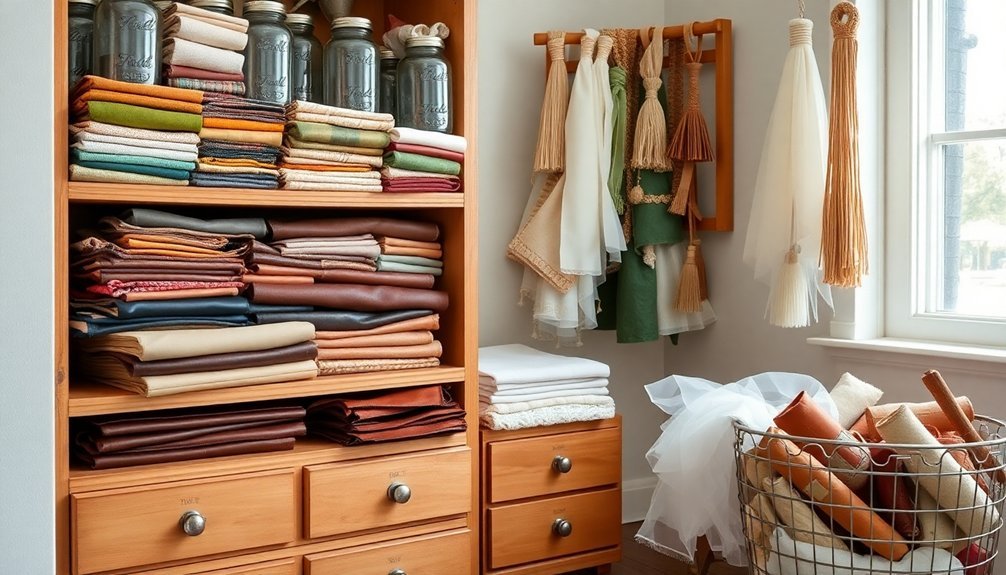
Since proper storage plays an essential role in zero-waste crafting, establishing an organized system for your trimmings is vital. You'll reduce the amount of waste while keeping your reusable materials in prime condition.
Use clear, labeled containers to prevent contamination and make materials easily accessible during your crafting process.
Key storage strategies to implement:
- Sort trimmings by category using airtight containers or vacuum-sealed bags to protect sensitive materials from degradation.
- Create a filing system for small scraps based on size or color to streamline your creative workflow.
- Dedicate a specific area in your workspace for storing trimmings, making them readily available and encouraging regular use.
Remember to periodically review and rotate your stored materials, incorporating older trimmings into new projects before they become unusable.
Creative Ways to Repurpose Soap Scraps
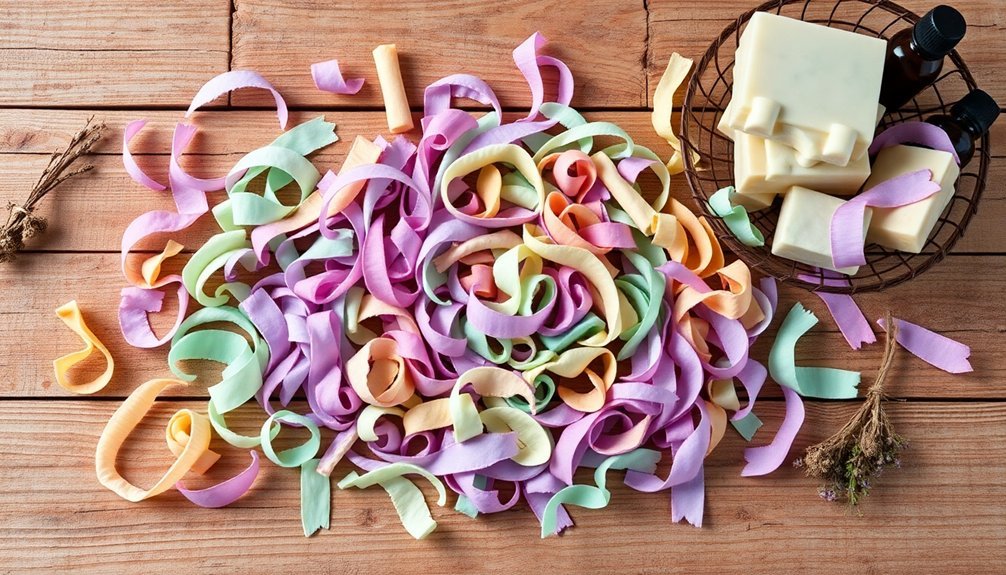
Building on effective storage practices, let's explore innovative uses for those seemingly worthless soap remnants.
You'll discover creative ways to reuse soap scraps that reduce your environmental impact while releasing your artistic potential.
Transform your leftover pieces by melting them down with water to create new custom bars, experimenting with colors and fragrances.
For a practical approach, shred your soap scraps to make a gentle, natural laundry detergent.
If you prefer liquid soap, combine the remnants with glycerin for an easy-to-dispense solution.
Get inventive with DIY crafts by incorporating soap scraps into homemade bath products.
Add them to scrubs and bath bombs for extra exfoliation, or design decorative soap sachets.
These simple techniques help you minimize waste while maximizing the value of your materials.
Melting and Reforming Techniques
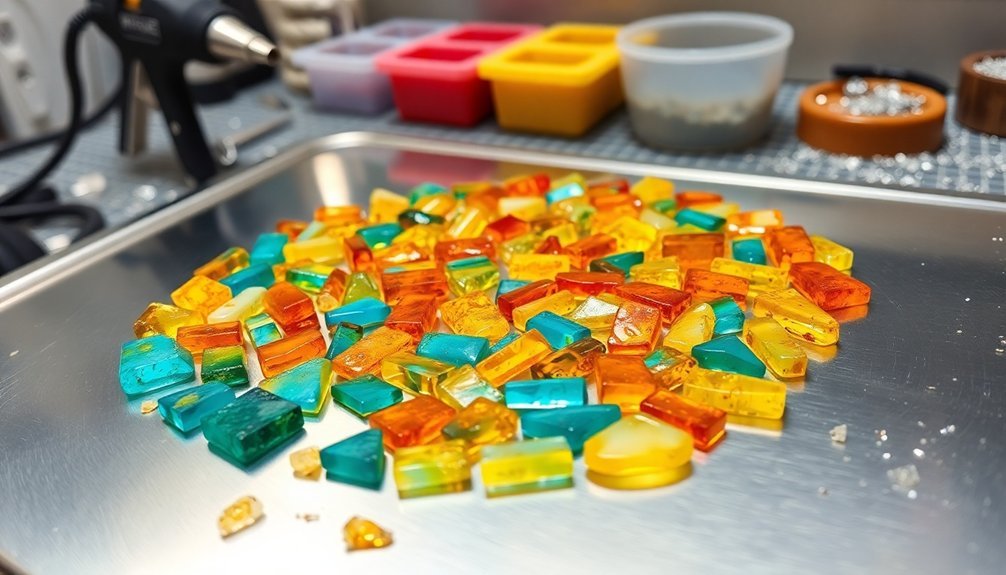
The art of melting and reforming materials opens up endless possibilities for repurposing craft remnants. By heating your leftover materials just below their melting point, you'll maintain their integrity while creating new, usable items. This sustainable approach helps you minimize waste while maximizing your creative potential.
Key benefits of melting and reforming techniques:
- You'll transform scraps into valuable materials, from candle trimmings to new wax creations.
- You can reuse soap remnants by melting them down into fresh bars.
- You'll reduce waste while exploring innovative design possibilities through various molds.
Remember to control your temperature carefully during the melting process to preserve the quality of your materials.
With proper techniques, you're not just saving money – you're contributing to a more sustainable crafting practice by giving new life to would-be waste.
Quality Control for Recycled Soap Products
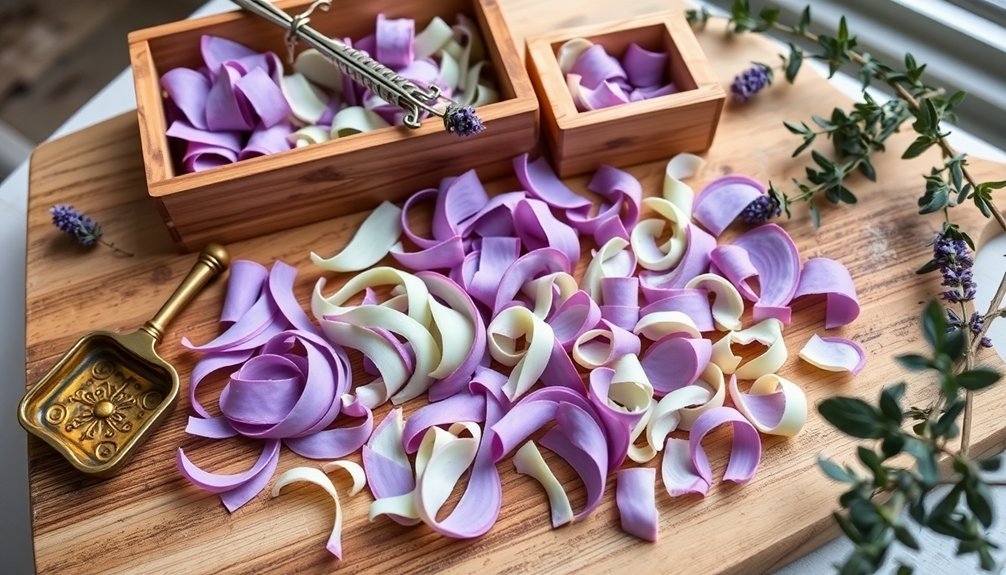
While melting and reforming techniques enable creative reuse of materials, maintaining strict quality standards guarantees your recycled soap products remain safe and effective. You'll need to implement thorough quality control measures to meet safety standards and protect your customers.
| Test Type | Purpose | Frequency |
|---|---|---|
| pH Testing | Confirm 9-10.5 range | Every batch |
| Microbial Testing | Check for harmful bacteria | Monthly |
| Consistency Check | Verify uniform texture | Every batch |
Remember to establish a traceability system that tracks your recycled materials from source to final product. This helps you monitor ingredient quality and troubleshoot any issues that arise. Always check your recycled soap's texture and consistency during production, as proper mixing is essential for maintaining product quality. Regular testing and documentation will help you build consumer trust while meeting regulatory requirements.
Sustainable Packaging Solutions
Sustainable packaging choices can make or break your zero-waste commitment as an artisan maker. By switching to biodegradable materials and reusable packaging solutions, you'll minimize environmental impact while building customer loyalty.
Embrace the circular economy by offering cloth bags or glass containers that customers can return for refills.
- Choose eco-friendly alternatives like recycled paper, compostable materials, or minimalist designs that reduce waste.
- Partner with local initiatives to access sustainable packaging supplies in bulk.
- Communicate your commitment through clear labeling that educates customers about your packaging choices.
Your packaging strategy doesn't just protect products—it's a powerful statement about your brand's values.
When you design snug-fitting packages and eliminate unnecessary materials, you're not only saving resources but also inspiring customers to join your zero-waste journey.
Economic Benefits of Soap Waste Recovery
Implementing soap waste recovery in your artisan business can slash raw material costs by up to 30% through smart reprocessing of trimmings and scraps.
You'll create additional revenue streams by transforming recovered soap waste into marketable products like sample bars and travel sizes.
Your bottom line will benefit from reduced material expenses while meeting the growing consumer demand for zero-waste products, as environmentally conscious customers are willing to pay premium prices for sustainable goods.
Cost Savings Through Reprocessing
Beyond the environmental impact, reprocessing soap waste offers considerable financial advantages for artisan makers. By implementing waste recovery systems, you'll transform discarded materials into new products while greatly reducing your production costs.
These sustainable practices can boost your profit margins by up to 30% through smart material reuse.
Here's how reprocessing directly impacts your bottom line:
- Save up to 30% on raw material costs by reusing soap trimmings and waste
- Reduce waste disposal expenses through efficient recovery systems
- Access government funding opportunities for sustainable business practices
Your commitment to waste recovery doesn't just save money—it attracts eco-conscious consumers who value sustainability.
With potential sales increases of 15-20%, you'll find that reprocessing isn't just good for the environment—it's essential for business growth and long-term profitability.
Profitable By-Product Sales
While many artisans discard their soap trimmings, these "waste" materials can become a lucrative revenue stream for your business.
You'll boost your revenue by 10-20% through profitable by-product sales while demonstrating your commitment to sustainability.
As an artisan maker, you can reduce waste by transforming soap scraps into new products with minimal additional resources.
The growing market for upcycled items means your environmentally conscious customers will appreciate your zero waste practices, leading to increased brand loyalty.
You'll find budget-conscious buyers enthusiastic to purchase bulk trimmings or mixed bundles.
Minimizing Raw Material Expenses
Raw material costs represent a significant portion of any artisan soap maker's budget, but smart waste recovery practices can dramatically reduce these expenses.
By implementing a thorough reuse strategy, you'll minimize waste while maximizing your profitability. Your eco-conscious customers will appreciate your commitment to sustainability, and you'll see immediate benefits in your bottom line.
- Save 10-30% on raw material expenses by collecting and repurposing soap trimmings
- Create new product lines like sample sizes and guest soaps from recovered waste
- Reduce disposal costs while enhancing your brand's environmental reputation
Transform your leftover soap scraps into valuable assets that boost your business efficiency.
You'll not only cut costs but also expand your product offerings without purchasing additional materials, creating a more sustainable and profitable operation.
Building a Zero-Waste Soap Making System
Start your zero-waste soap making journey by creating a dedicated system to collect and organize your soap scraps, storing them in clearly labeled containers based on their scents and properties.
You'll find countless opportunities to transform these remnants into new products, from rebatching them into fresh bars to creating sample-sized soaps for promotions.
Beyond the soap itself, you can strengthen your commitment to sustainability by reusing packaging materials, such as incorporating recycled paper for wrapping and repurposing containers for storage.
Repurposing Soap Scraps
A thorough zero-waste soap making system isn't complete without a strategy for repurposing soap scraps.
As an environmentally conscious artisan, you'll find numerous ways to reuse these valuable remnants while enhancing your sustainable practices.
Transform your soap scraps into new products with these creative approaches:
- Melt down trimmings with a touch of water to create fresh bars, perfect for your eco-friendly product line.
- Incorporate scraps into homemade laundry detergent or natural exfoliating scrubs.
- Launch a unique "scrap soap" collection by blending various leftover pieces into artisanal bars.
Upcycling Packaging Materials
While building a zero-waste soap making system, packaging materials present endless opportunities for creative upcycling.
You'll find that cardboard boxes, glass jars, and plastic containers can serve as excellent molds and storage solutions for your soap-making journey.
Don't toss those empty essential oils bottles – they're perfect for measuring and storing new ingredients.
Transform old towels and fabric scraps into attractive soap wraps and labels, adding a personal touch while reducing waste.
You can also connect with other artisans through local economy initiatives, swapping packaging materials and sharing resources.
By participating in community exchanges, you're not only saving money but also contributing to waste reduction efforts.
Remember to clean and sanitize all repurposed containers thoroughly before use, ensuring your upcycling practices maintain professional standards.
Frequently Asked Questions
What Are the 5 Rules of Zero Waste?
You'll follow five key zero waste rules: Refuse what you don't need, Reduce your consumption, Reuse items whenever possible, Recycle as a last resort, and Rot (compost) your organic waste to minimize landfill impact.
What Are the 10 Examples of Reuse?
You can reuse glass jars for storage, turn old clothes into rags, repurpose cardboard boxes, transform wine bottles into vases, use plastic containers for planters, convert tires into swings, and make tote bags from t-shirts.
What Are 5 Items You Can Reuse and How?
You can transform fabric scraps into patchwork bags, turn wood offcuts into coasters, use paper trimmings for gift tags, repurpose glass jars as planters, and convert bottle caps into creative magnets.
What Are 5 Examples of Reduce, Reuse, and Recycle?
You can reduce paper by going digital, reuse glass jars for storage, recycle cardboard boxes, reduce energy by using LED bulbs, and reuse clothing through donations. These choices help minimize environmental impact.
In Summary
You'll find that implementing a zero-waste soap making system transforms your artisan practice while boosting your bottom line. By collecting trimmings, mastering proper storage, and learning reformation techniques, you're creating a sustainable cycle that benefits both your business and the environment. Don't let those valuable scraps go to waste – start your zero-waste journey today and watch your efficiency soar.

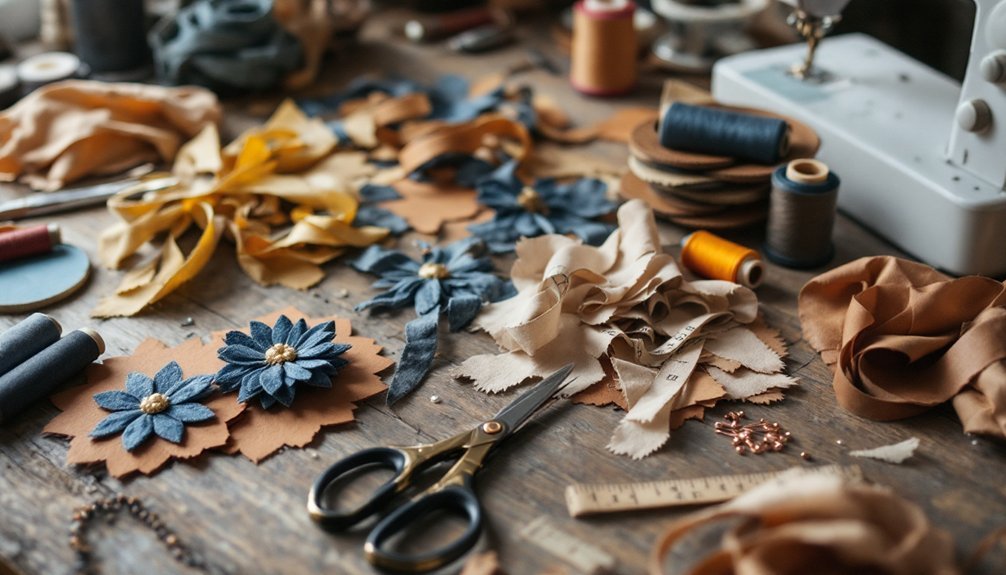



Leave a Reply